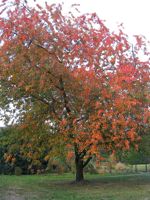Mon-Fri 9am - 5pm Mountain time
Black Cherry vs Sweet Thing Cherry
Prunus serotina
Prunus cerasus Sweet Thing
NOT AVAILABLE THIS SEASON - MIGHT RETURN
NOT AVAILABLE THIS SEASON - MIGHT RETURN
Black Cherry is common in eastern North America but a rare find elsewhere. This tree is shade tolerant and is often found in old fields, forest openings, and along fencerows.
The fruit is edible and is commonly used to flavor rum and brandy. It is also edible and often eaten fresh or used in wine or jelly. Black Cherry trees typically begin producing fruit when they are 10 years of age.
Black Cherry wood is a rich reddish-brown color and is strong, making it valued in cabinetry and woodworking. It is often used in reclamation as well.
The leaves can poison livestock as they contain cyanide derivatives and precursors. However, many have noted that deer still seem to browse their trees with impunity and birds and other animals eat the fruit when available.
The Sweet Thing Cherry is a sour cherry hybrid of Carmine Jewel and Erdi Jubileum that produces sweeter and firmer berries than other cold-hardy sour cherry varieties. The berries are a deep burgundy red and quite sweet, making them excellent for fresh eating and also desserts, jams and jellies.
The Sweet Thing Cherry, or the Jubileum, is highly suckering so it can establish your hedge quickly, or fill in gaps.
Black Cherry Quick Facts
Sweet Thing Cherry Quick Facts
Toxicity: bark and wilted leaves toxic to livestock

